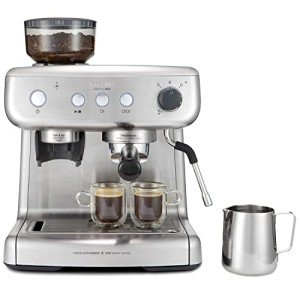Home Use Espresso Machines: A Comprehensive Guide
Espresso machines have become a staple in lots of families as coffee lovers seek to replicate café-quality brews in the convenience of their kitchens. The rise in appeal has led to a diverse market filled with different designs, features, and costs. This article intends to supply a useful summary of home use espresso machines, helping readers browse their alternatives efficiently.
Comprehending Espresso Machines
Espresso machines work by forcing hot water through finely-ground coffee under high pressure, resulting in a concentrated coffee drink understood as espresso. There are a number of types of espresso machines classified based upon their developing approaches and level of automation. The most common types include:
- Manual Espresso Machines: These need the user to manage the pressure and water flow, enabling for a more hands-on coffee-making experience.
- Semi-Automatic Espresso Machines: These use automatic control over water pressure, while the user by hand grinds and tamps the coffee.
- Automatic Espresso Machines: With the push of a button, these machines immediately manage the circulation of water, making it easier to brew espresso with consistent outcomes.
- Super-Automatic Espresso Machines: These all-in-one machines handle grinding, tampering, brewing, and even milk frothing, making them ideal for users trying to find benefit.
- Capsule or Pod Machines: These use pre-packaged coffee pods to develop espresso with very little effort, however they limit choice in brewing techniques and tastes.
Table: Comparison of Espresso Machine Types
| Type | Control Level | Reduce of Use | Cleaning up Level | Suitable For |
|---|---|---|---|---|
| Manual | User-controlled | Moderate | High | Coffee perfectionists |
| Semi-Automatic | Partial automation | Moderate | Moderate | Home baristas |
| Automatic | Totally automated | Easy | Low | Busy individuals |
| Super-Automatic | Totally automated | Very easy | Very low | Convenience hunters |
| Capsule/Pod | Fully automated | Really simple | Extremely low | Casual drinkers |
Secret Features to Consider
When selecting a home use espresso machine, it's vital to think about various features that can significantly impact the quality of espresso and user experience.
- Pressure: Look for machines that provide at least 9 bars of pressure, as this is considered optimal for developing espresso.
- Boiler Systems: Single vs. dual boiler systems figure out temperature level stability and the ability to brew espresso and steam milk concurrently.
- Grinder: Integrated grinders enable for newly ground coffee, which enhances taste. Consider machines with adjustable grind settings.
- Milk Frother: For those who enjoy cappuccinos and lattes, a built-in steam wand or automatic frother is essential.
- Size and Design: Consider your kitchen space and aesthetic preferences. Machines come in different sizes, from compact to big setups.
- Price: Home espresso machines can range from a couple of hundred to a number of thousand dollars, so it's essential to develop a budget before exploring choices.
Benefits and drawbacks of Home Use Espresso Machines
| Pros | Cons |
|---|---|
| Benefit of brewing coffee in the house | Initial financial investment can be high |
| Quality of espresso is frequently superior | Needs some ability, especially with manual machines |
| Ability to explore tastes | Maintenance and cleansing can be labor-intensive |
| Can conserve money in the long run | Not all machines will match every coffee choice |
Maintenance and Cleaning Tips
Maintaining an espresso machine is important for lengthening its life and ensuring constant brew quality. Here are some beneficial pointers:
- Regular Descaling: Minerals from water can build up in the machine. Latte Machines -3 months, depending upon water firmness.
- Daily Cleaning: Rinse portafilters, baskets, and steam wands after each use to prevent coffee oils from constructing residue.
- Use Filtered Water: This can assist reduce mineral accumulation and improve the taste of coffee.
- Change Gaskets and Seals: These parts may wear gradually and must be replaced to keep pressure and performance.
- Check out the Manual: Each machine has specific care directions; following these will ensure longevity.
FAQs About Home Use Espresso Machines
Q1: What is the best budget espresso machine?The best budget espresso machine typically depends on private requirements, but models like the DeLonghi EC155 or the Breville Bambino are popular among users for providing fantastic worth. Q2: How long do home espresso machines usually last?With proper upkeep, home espresso machines can last anywhere from 5 to 15 years, depending on the quality of the machine and frequency of use. Q3: Can I make coffees and lattes with any espresso machine?While most espresso machines can make cappuccinos and lattes, having a reliable
steam wand or frother is important for achieving the best milk texture.
Q4: Are super-automatic machines worth the investment?For those who focus on benefit and fast brewing, super-automatic machines can be worth the investment, though they might do not have some customizability in brew strength and flavor. Q5: What kinds of coffee beans are best for espresso?While Single-Serve Espresso Machines plays a role, beans identified as" espresso "blends are typically roasted darker, creating rich tastes and a creamy texture when brewed.
Investing in a home espresso machine can change the day-to-day coffee routine into something special, raising home brews to café quality. By understanding the various types of machines, crucial functions to consider, maintenance requirements, and weighing the
benefits and drawbacks, consumers can make informed choices that match their specific choices. As the espresso culture continues to grow, no matter the choice, every brew can be a scrumptious experience waiting to be appreciated.

